Super Mario Bros. Wonder on Switch
Super Mario Bros. Wonder is the 2D Mario game we’ve all been waiting 10 years for, and it succeeds in its premise. Not only does Super Mario Bros. Wonder continue the rich 2D Mario tradition with success, but it also evolves the format to new heights while setting itself completely apart from Mario Maker. Even though none of the stages in Super Mario Bros. Wonder could be created in Mario Maker, this is still a traditional Mario game through and through. Nintendo did a great job maintaining the traditional 2D Mario identity while doing something wholly fresh and innovative. So, let’s stop wondering why they took 10 years and get on with the Super Mario Wonder review now, shall we?
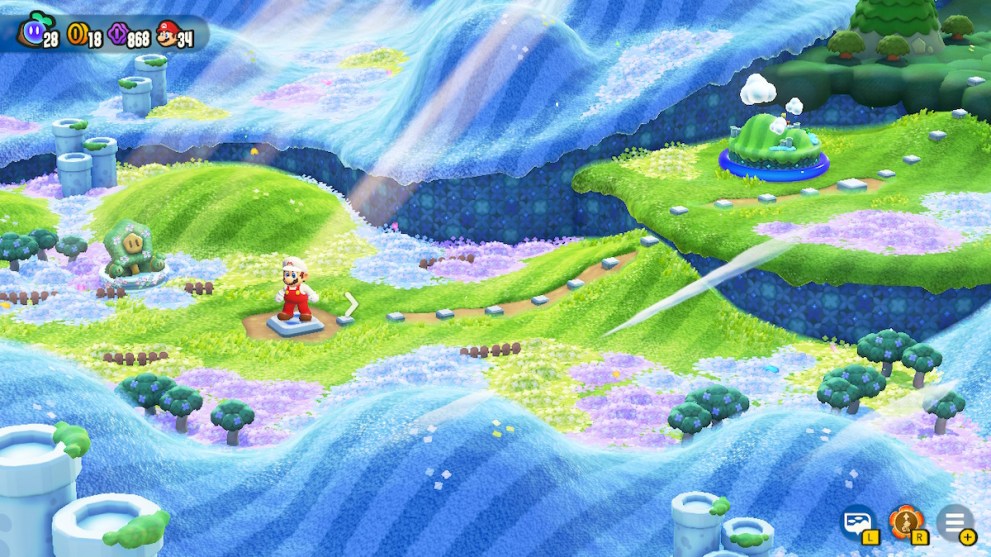
The first thing you’ll notice when booting up Super Mario Bros. Wonder is the absolutely vibrant color palette. The visuals are strikingly beautiful and seem to pop off the screen with richness. There are little details in the foreground and backgrounds of each stage that liven up each level and decorate them in really unique ways. As you’re scrolling through a level, you’ll often see denizens of the Flower Kingdom chilling out in the background or lightly animated clouds moving in the background while snow gently falls in the foreground.
Each of the worlds in Super Mario Bros. Wonder has a distinctly unique theme that is shared between the overworld and levels. Even if you somehow get tired of a particular world’s theming, you’ll never get repeated level palettes. Each stage is truly unique from one another, even if they share a theme. In particular, the snowy Fluff-Puff Peaks world left me in awe as little lit-up villages with lights hung around festive trees dotted the landscape. Oh, and the music just puts a ribbon over the snowy scene with its frosty piano and sleigh bells. Music helps differentiate each world’s theme, but I did notice that plenty of levels will share the same track within the worlds.
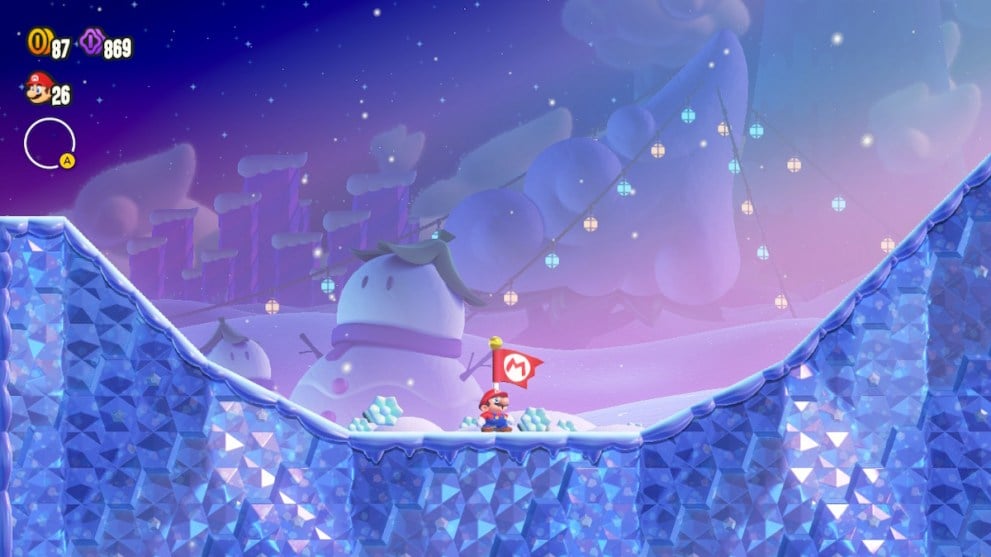
Gone are the repetitive “Ba, ba, ba!” sing-along stylings of the New Super Mario Bros. Games. With Super Mario Wonder, singing koopas have been replaced with talking flowers quipping on each level’s eccentricities. Oh, there are sing-along moments no doubt, but they take a far more dynamic form that will put a smile on your face as you play the game similar to the music stages in something like Rayman Legends.
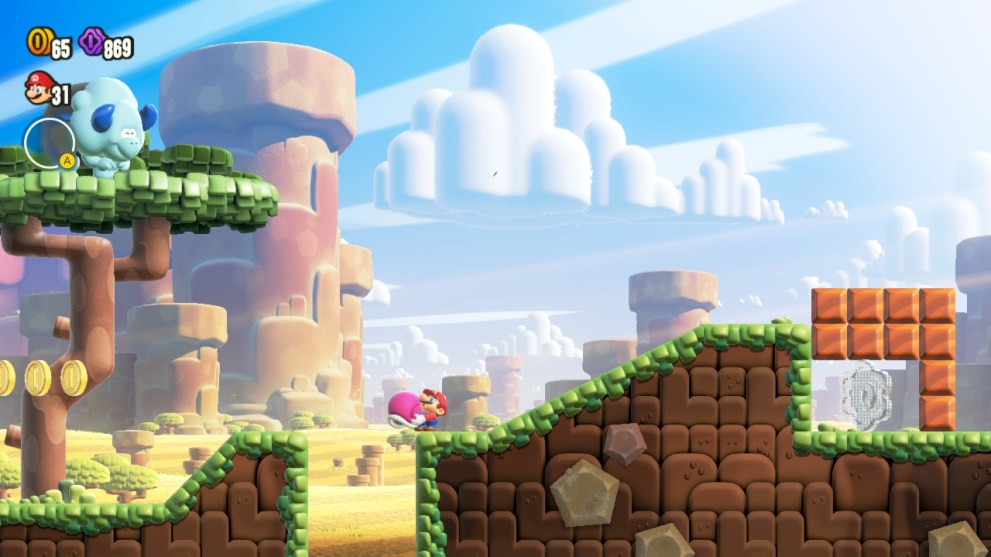
It’s impossible to frown while playing this game; if the chipper music doesn’t prevent you, the amazingly fun gameplay will. Controls are straightforward if you’ve ever played a Mario game in the past. Your traditional Mario movements are all here from the running high jump to the crouch walk. One of the small joys in Mario games is the clarity of all the terrain you jump on. The tremendous visuals make it easy to know where you’re jumping with fantastic visual distinction between enemies, platforms, and stage decorations. Death pits are indicated by a darkened shadow around the perimeter and the uninteractable foreground and background decorations are indicated by the blur effect and unique animation.
You never feel like a jump was unfair due to fussy animations or inaccurate hitboxes. Every interaction in Super Mario Bros. Wonder is clean and smooth as butter, without any vagueness whatsoever. While I wouldn’t quite put Mario Wonder in the category of precision platformer, it certainly is precise and features some of the most advanced hit detection in any 2D platforming game I’ve played. You can get ridiculously close to enemies or spikes without the proximity killing your character. It really is coded down to the micro pixels to avoid unfair deaths and vague platforming.
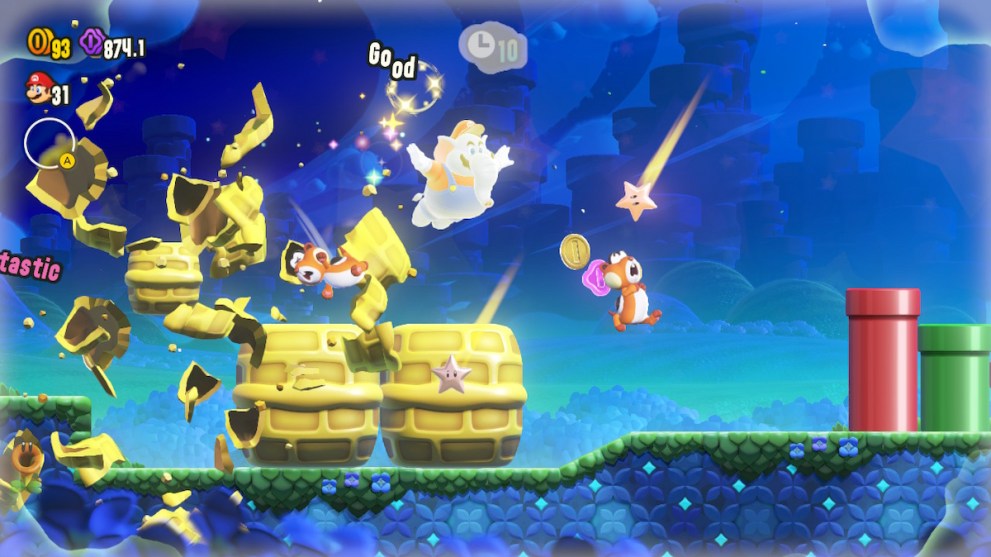
It’s good that the platforming is so precise because Elephant Mario is going to need all the precision his bumbling form can get. Yes, one of the new power-ups is an elephant version of any of the seven (of 12) playable characters. This new form plays wonderfully well and can somehow fit in pipes and tight spaces just fine. The most transformative element of the elephant form is using the trunk to spew water, resulting in a number of different consequences depending on context. It’s a shame that there aren’t any other animal forms besides the elephant one; however, there are some neat power-ups like the drill and the bubble.
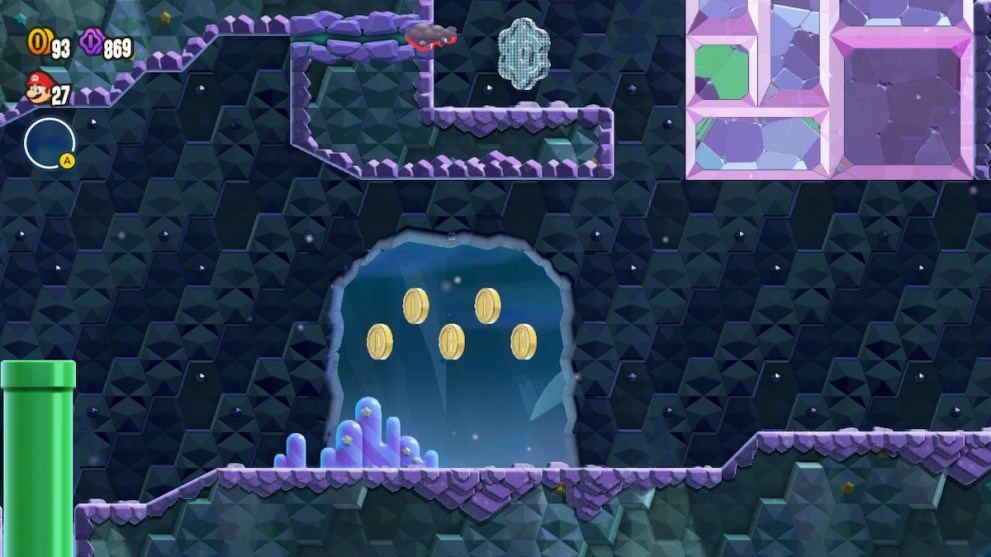
The drill cuts into soft patches of dirt, allowing the player to dig directly under the path to avoid enemies or strike them from below (or above!). There are some really unique levels that make fun use of this power sure to delight Dig-Dug fans. The bubble is useful for its ability to create temporary jump platforms in the air. I love blowing bubbles and chaining jumps on them as I create my own route through a level, reminiscent of the spider web platforms in Donkey Kong Country 2.
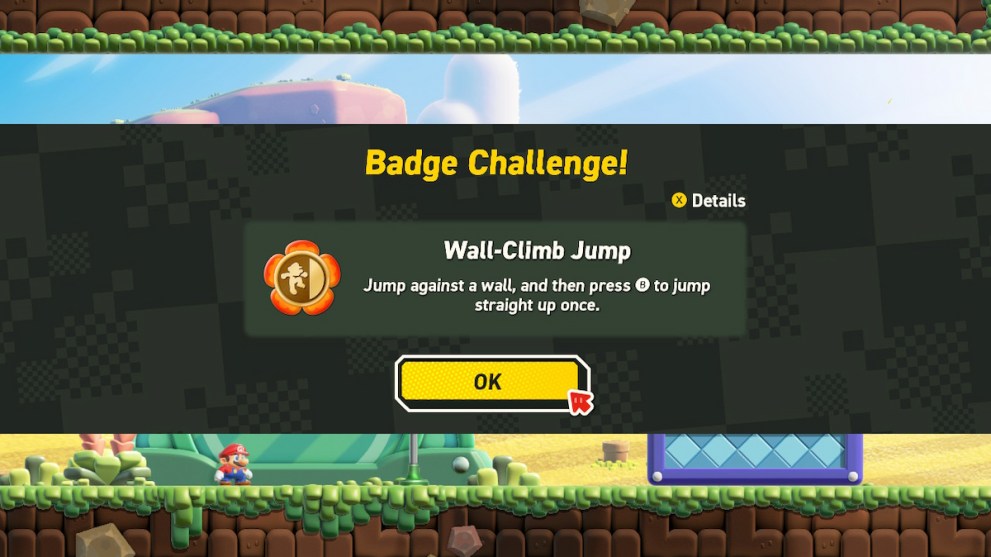
Badges create even more options for Mario and friends apart from just the cool power-ups. Think of badges as an equippable enhancement or ability. Badges are divided into three categories: action badges, boost badges, and the far more rare expert badges. Action badges are the fun ones that give abilities such as double jump, or even a cool vine grappling hook. Boost badges are passive enhancements like more coins earned or a safety bounce that recovers you from a fall. Having this level of actionable customization adds an RPG element to the strategy. Do you tackle this 5-star difficulty stage with something that gives Mario extra jumping height? Or, do I opt for the safety bounce fall recovery badge?
Badges offer customizable difficulty options and provide alternate ways to go through each level. The badge system is transformative, even if each one individually doesn’t truly transform the game. If I have one complaint leveled at the power-ups and badges, it’s that there’s only one animal form in the game. I’m not the only one who expected there to be more animal forms, right?
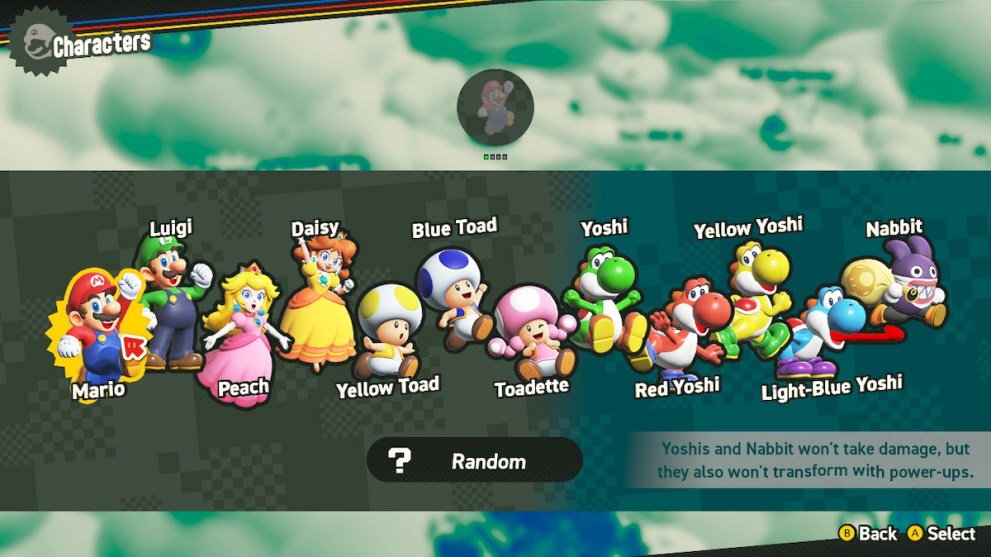
The 12 playable characters also offer some customizable difficulty in the form of Yoshis and Nabbit. Both Yoshi and Nabbit are invulnerable to all damage, but they also cannot use power-ups and transform. This lack of power-up ability greatly limits these characters’ options in the levels. Good thing, then, that both Yoshi and Nabbit actually control differently than the other characters because all the seven others control identically to one another with no differentiating gameplay between them. Sure, the animations are unique, but I would have liked Luigi to have a higher jump or Toad to be the faster runner like in Super Mario Bros. 2.

The roster of playable characters serves the multiplayer of Super Mario Bros. Wonder nicely. Just like there are 12 characters to pick from, multiplayer lobbies will house up to 12 players for the overworld zones. Up to four players can simultaneously do levels together during either local or online play. What’s interesting about this game’s multiplayer is that Super Mario Bros. Wonder has removed collision with other players completely. Remember how hectic New Super Mario Bros multiplayer was? That wasn’t co-op, it was outright slaughter. Mario multiplayer became a meme for its penchant for making enemies since most players opted to just push their friends into lava instead of actually helping them out.
Super Mario Wonder also has a cool Souls-like standee system which allows players to put a checkpoint anywhere in the level for online and local players to spawn at. Finally, there’s the ghost system, which makes you a controllable ghost if you fail with five seconds to tag another player. All of these multiplayer components make the experience more inviting for actual co-op play and make it more fun to enjoy the level design than previous 2D Mario games.
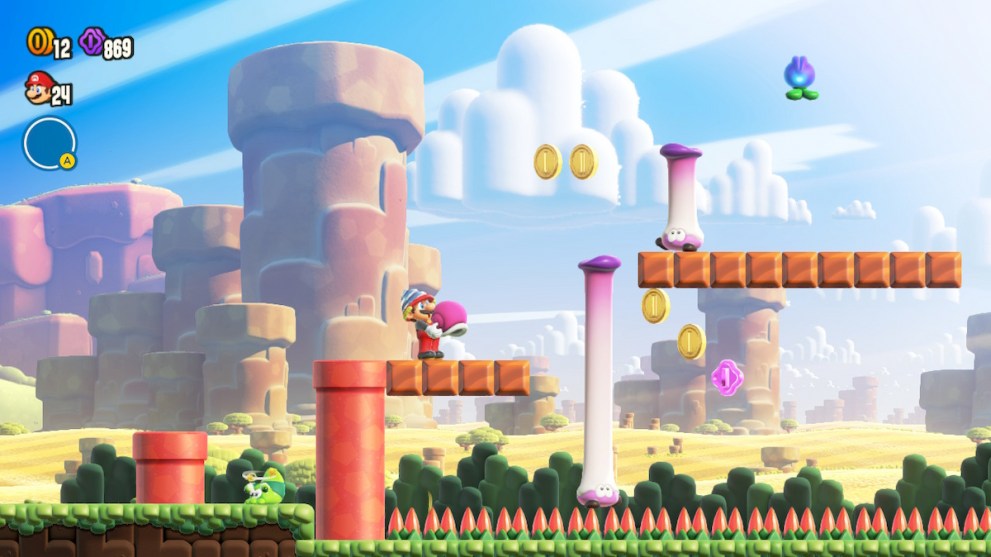
While the variety of playable characters is a tad more limited than I had wanted, the enemy variety is quite the opposite; it’s overwhelming. Every single level features at least one new enemy or creature. There are no palette-swapped enemies, and they all have unique animations and abilities that influence how one navigates the level. Without hyperbole, Super Mario Bros. Wonder features the best enemy variety of any 2D platforming game I’ve ever played.
It’s a shame, then, that the boss fights are unremarkable and follow the same patterns that we’re all used to by now. While I can’t reveal some of the identities of the bosses, just know that you’ve seen them before, but this time using wonder power to fight Mario. These boss fights are dull and don’t hold the same variety and craft the rest of the game does.
I’m not too impressed with the palaces these boss fights take place in either. The final stages of each world are less creative than the Bowser castles of classics like Super Mario World. Some of these boss levels lack good checkpointing and rely on autoscrolling for their difficulty. Super Mario Wonder’s lackluster boss fights and boss levels contradict the rest of the game’s endlessly creative design.

And boy does this game have variety in its excellent level design. But before touching on variety, it’s worth touching on what makes each level so good. There’s a satisfying flow to levels that accommodate all styles of play. Speedrunning through stages feels satisfying with clear ramps and obstacles paced perfectly for speed, while slow exploration rewards methodical players with tons of hidden secrets and easter eggs. There’s carefully planted checkpointing throughout each level and tremendous show-don’t-tell tutorialization.
But most Mario games have that masterful design to them, right? What makes Super Mario Bros. Wonder unique is the variety. ‘Wonder’ is in the title for a reason; it represents the feeling of the unknown staring every player in the face as they stroll onto the next stage never knowing what they’ll see and experience.
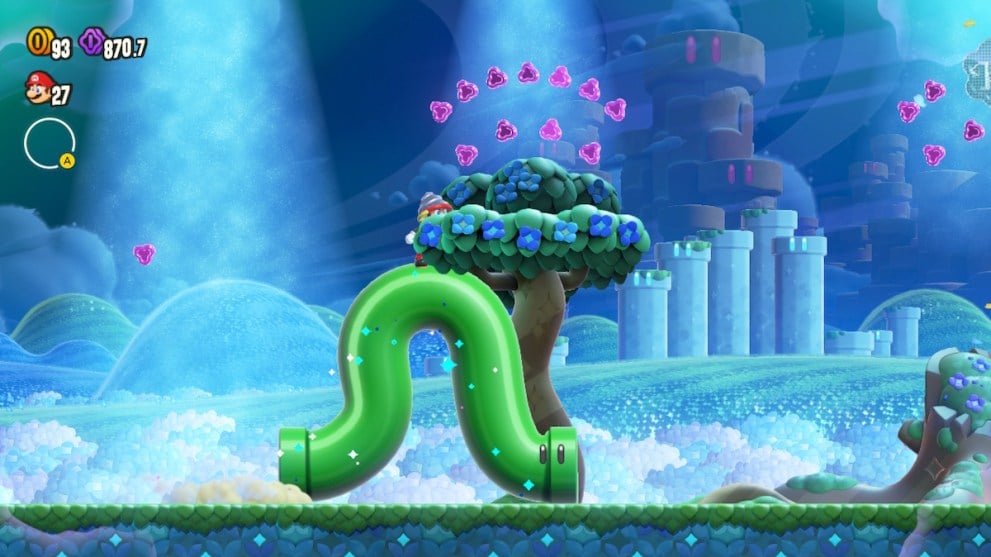
The best examples of the ridiculous kind of variety present in the game are the Wonder Flowers present in each of the game’s many levels. Small talking flowers will usually alert you when a Wonder Flower is nearby, and they’re usually impossible to miss thanks to their unique sound and large size. Jump into one and the laws of reality start to bend. There’s one Wonder Flower per stage that transforms the rest of the level into something truly unique.
Some Wonder Flowers grow the enemies and objects around the environment to ridiculous proportions. My favorite Wonder Flower effect transforms the rest of the level into an absurd musical number. The charm is over-the-top during these wondrous moments and reminds us why Mario remains so special all these years later.
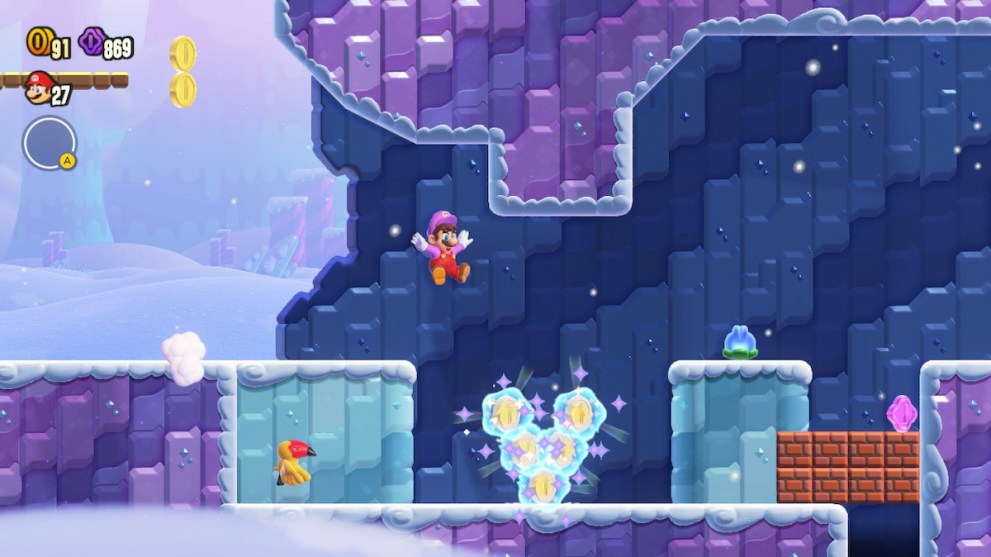
Wonder Flowers are more than mere set-piece moments; they essentially serve as an alternate route through a level. What really makes each stage replayable is that there are some purple coins and wonder seeds only obtainable by opting out of the wonder flower transformation. There are also some secret flagpole exits that unlock secrets around the world map. Whether it’s the three purple coins, the multiple wonder seeds, or alternate routes and exits, each stage has great replayability. I found myself replaying the same levels in this game to witness all its secrets more than in any other 2D Mario in the past. The wonder flowers really do alter the gameplay in cool ways that frequently put a smile on my face, and the many secrets tucked throughout the Flower Kingdom keep me playing many hours after seeing the credits.

These fresh gimmicks and unique concepts are a direct response to the open template Super Mario Maker provided. There’s not a single stage in Super Mario Wonder that could have been created in either Mario Maker game. Every stage features unique enemies, a new masterfully designed gimmick, or a new style entirely. Nintendo challenged themselves to make a 2D Mario game where not an ounce of it can be recreated in Mario Maker, and they succeeded.
This constant variety is all sugars and rainbows, but sometimes you may want some meat mixed in. The constant new introduction of concepts, enemies, and gimmicks necessarily makes it so progressive iteration on existing concepts isn’t fleshed out as well as one might have hoped. Still, Super Mario Bros. Wonder has plenty of difficulty with its optional content and its highly customizable badge system.
I simply loved playing Super Mario Bros. Wonder and don’t think another game this year has made me smile as much as this one. It’s a delightful platformer that continues Mario’s 2D legacy into the future with fresh design concepts and gimmicks you wouldn’t have seen a mile away. Now that Super Mario Bros. Wonder has proved that the 2D Mario format still has fresh new tricks up its sleeve, I’d love to see how they iterate on it in their next games.
- Great visual/audio presentation
- Masterful level design from top to bottom
- Every single stage features unique enemies and gimmicks
- High replayability due to all the coins to collect and hidden secrets
- Boss battles are dull and uninspired
- The sheer variety of concepts means less iteration and less difficulty

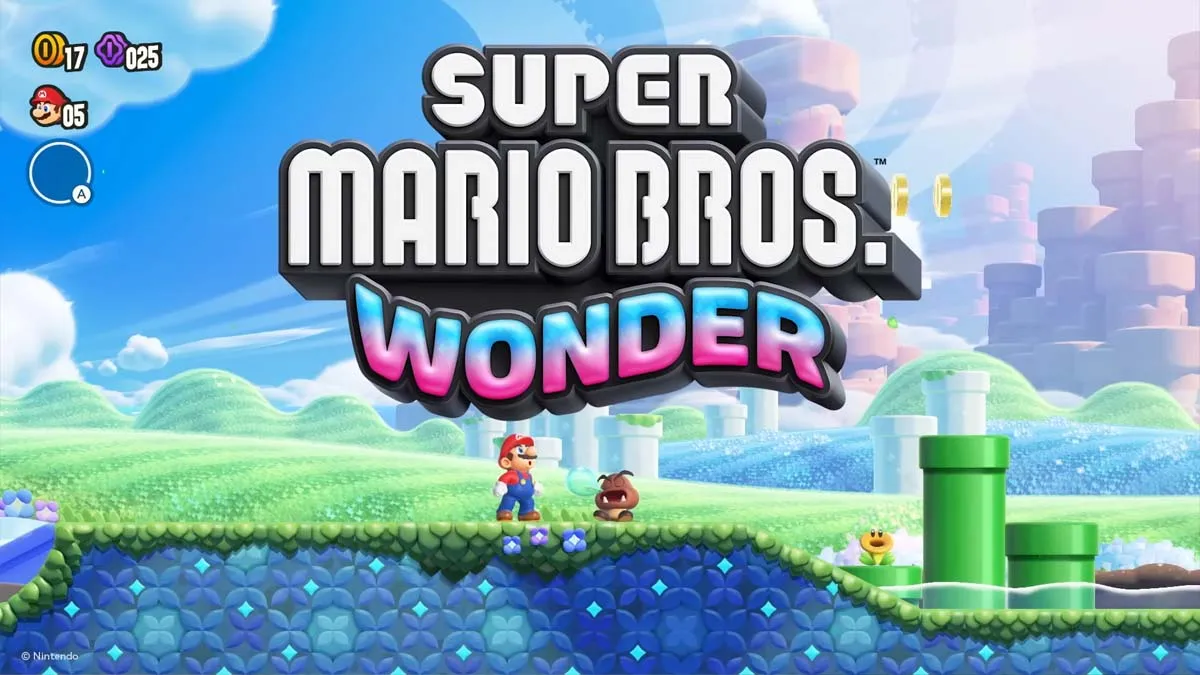


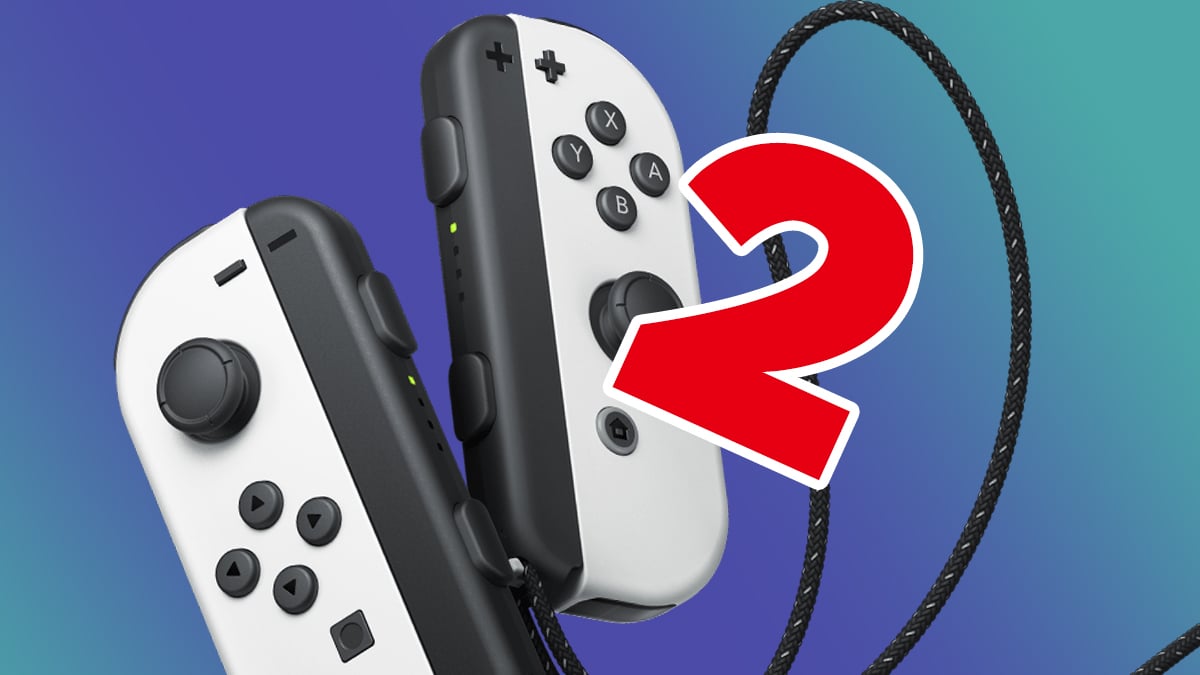

Published: Oct 18, 2023 09:00 am